The Influence of Cross-Cultural Leadership on Employee Performance
VerifiedAdded on 2020/05/11
|53
|9153
|72
Report
AI Summary
This report examines the impact of cross-cultural leadership on employee motivation and encouragement within Australian business organizations. It explores the importance of cross-cultural leadership in managing communication between employees from diverse cultural backgrounds, especially in the context of a globalized business environment. The research investigates the positive effects of cross-cultural leadership on employee performance, addressing challenges like cross-cultural barriers to communication and providing insights into overcoming them. The report includes a literature review, research methodology, findings and analysis of the impact of tangible and non-tangible benefits on motivation, and concludes with recommendations for improving cross-cultural leadership skills and enhancing organizational efficiency. The study also discusses the limitations associated with the research, such as the sampling method used and lack of qualitative analysis.
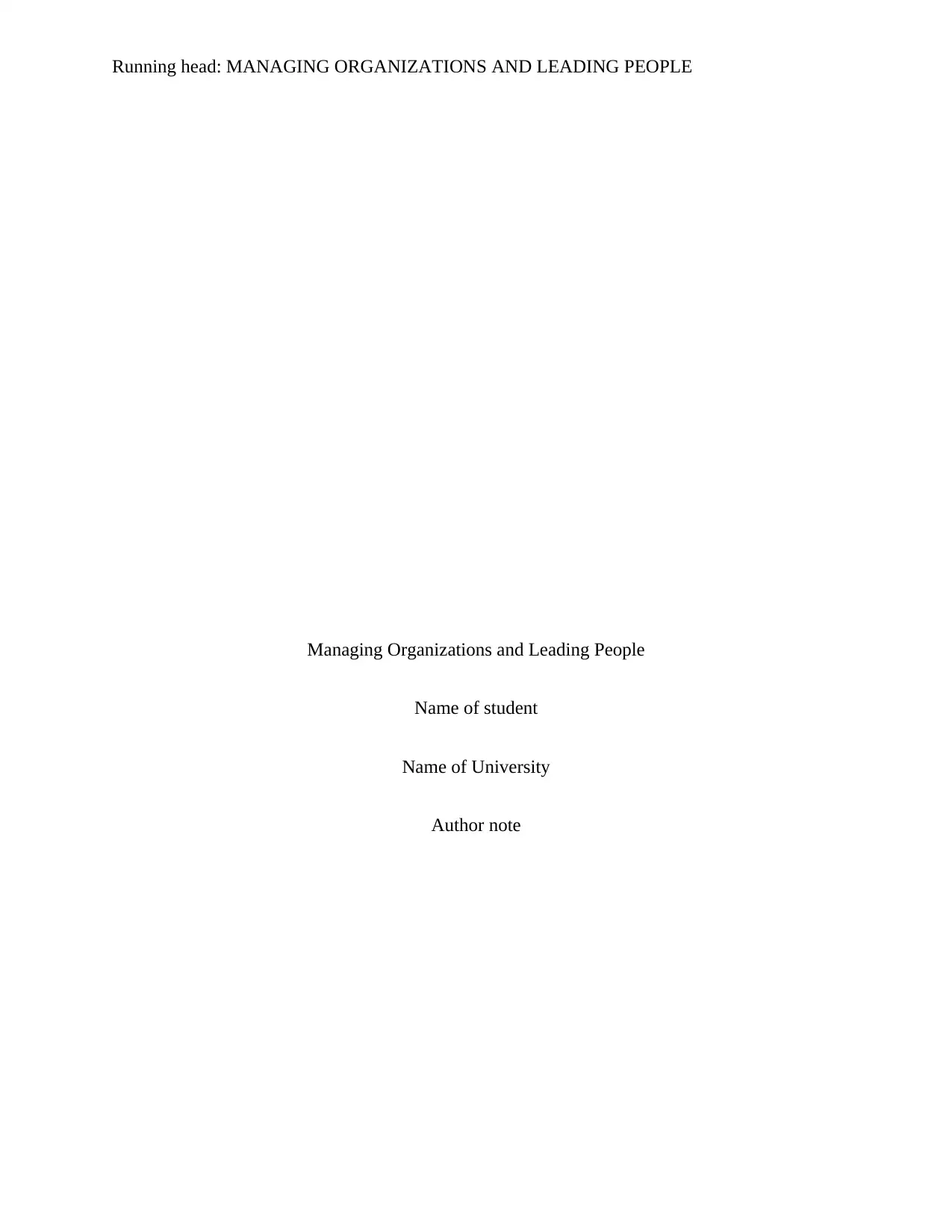
Running head: MANAGING ORGANIZATIONS AND LEADING PEOPLE
Managing Organizations and Leading People
Name of student
Name of University
Author note
Managing Organizations and Leading People
Name of student
Name of University
Author note
Paraphrase This Document
Need a fresh take? Get an instant paraphrase of this document with our AI Paraphraser
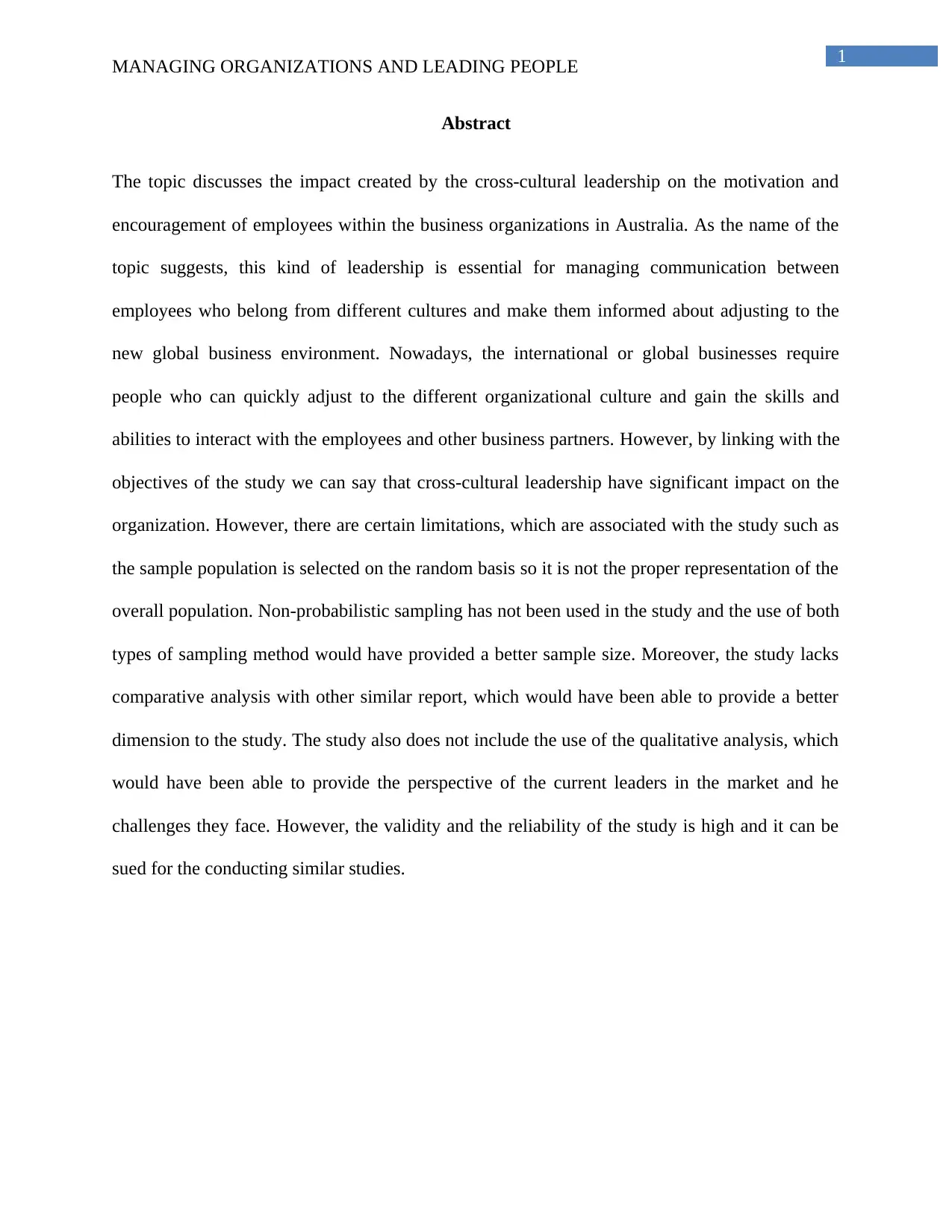
1
MANAGING ORGANIZATIONS AND LEADING PEOPLE
Abstract
The topic discusses the impact created by the cross-cultural leadership on the motivation and
encouragement of employees within the business organizations in Australia. As the name of the
topic suggests, this kind of leadership is essential for managing communication between
employees who belong from different cultures and make them informed about adjusting to the
new global business environment. Nowadays, the international or global businesses require
people who can quickly adjust to the different organizational culture and gain the skills and
abilities to interact with the employees and other business partners. However, by linking with the
objectives of the study we can say that cross-cultural leadership have significant impact on the
organization. However, there are certain limitations, which are associated with the study such as
the sample population is selected on the random basis so it is not the proper representation of the
overall population. Non-probabilistic sampling has not been used in the study and the use of both
types of sampling method would have provided a better sample size. Moreover, the study lacks
comparative analysis with other similar report, which would have been able to provide a better
dimension to the study. The study also does not include the use of the qualitative analysis, which
would have been able to provide the perspective of the current leaders in the market and he
challenges they face. However, the validity and the reliability of the study is high and it can be
sued for the conducting similar studies.
MANAGING ORGANIZATIONS AND LEADING PEOPLE
Abstract
The topic discusses the impact created by the cross-cultural leadership on the motivation and
encouragement of employees within the business organizations in Australia. As the name of the
topic suggests, this kind of leadership is essential for managing communication between
employees who belong from different cultures and make them informed about adjusting to the
new global business environment. Nowadays, the international or global businesses require
people who can quickly adjust to the different organizational culture and gain the skills and
abilities to interact with the employees and other business partners. However, by linking with the
objectives of the study we can say that cross-cultural leadership have significant impact on the
organization. However, there are certain limitations, which are associated with the study such as
the sample population is selected on the random basis so it is not the proper representation of the
overall population. Non-probabilistic sampling has not been used in the study and the use of both
types of sampling method would have provided a better sample size. Moreover, the study lacks
comparative analysis with other similar report, which would have been able to provide a better
dimension to the study. The study also does not include the use of the qualitative analysis, which
would have been able to provide the perspective of the current leaders in the market and he
challenges they face. However, the validity and the reliability of the study is high and it can be
sued for the conducting similar studies.
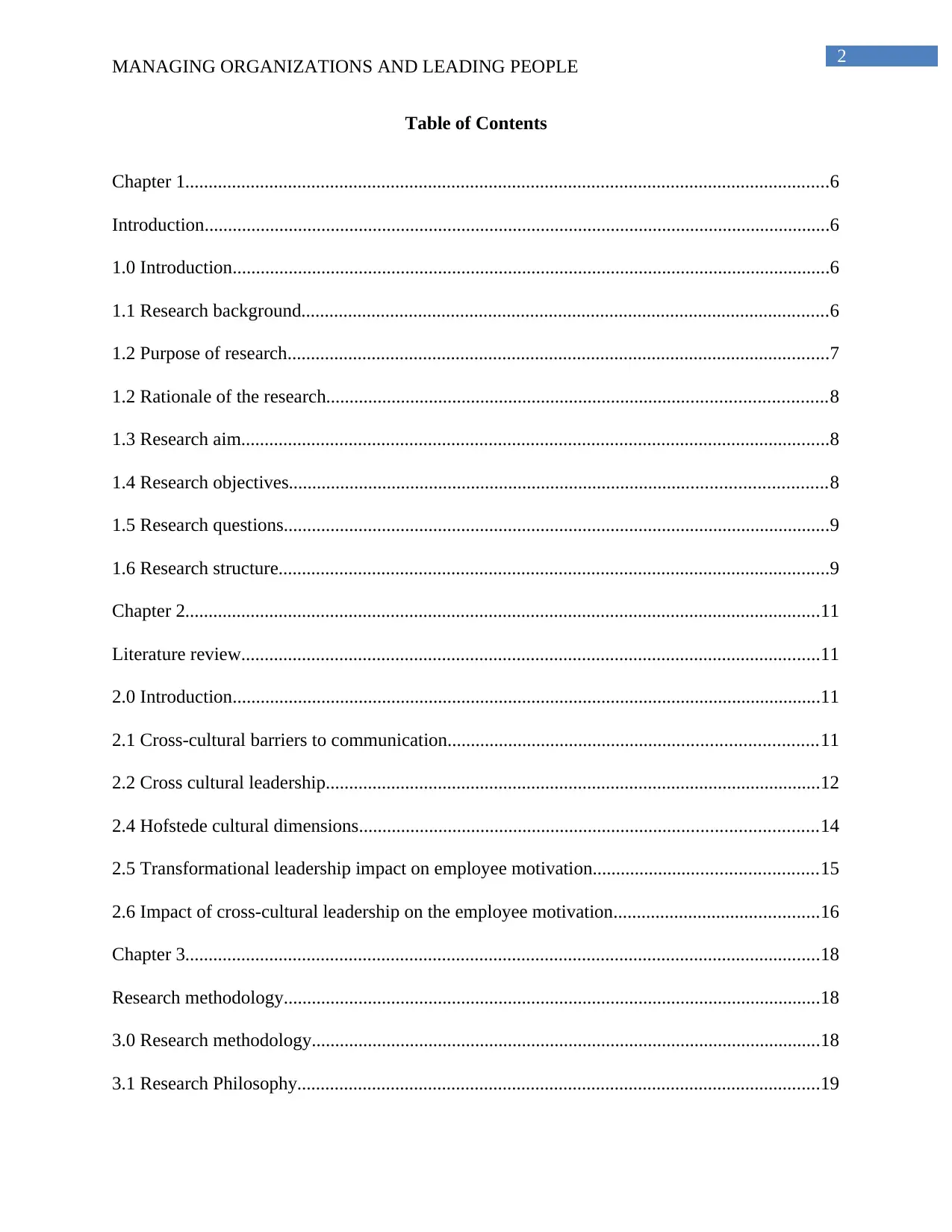
2
MANAGING ORGANIZATIONS AND LEADING PEOPLE
Table of Contents
Chapter 1..........................................................................................................................................6
Introduction......................................................................................................................................6
1.0 Introduction................................................................................................................................6
1.1 Research background.................................................................................................................6
1.2 Purpose of research....................................................................................................................7
1.2 Rationale of the research...........................................................................................................8
1.3 Research aim..............................................................................................................................8
1.4 Research objectives...................................................................................................................8
1.5 Research questions.....................................................................................................................9
1.6 Research structure......................................................................................................................9
Chapter 2........................................................................................................................................11
Literature review............................................................................................................................11
2.0 Introduction..............................................................................................................................11
2.1 Cross-cultural barriers to communication...............................................................................11
2.2 Cross cultural leadership..........................................................................................................12
2.4 Hofstede cultural dimensions..................................................................................................14
2.5 Transformational leadership impact on employee motivation................................................15
2.6 Impact of cross-cultural leadership on the employee motivation............................................16
Chapter 3........................................................................................................................................18
Research methodology...................................................................................................................18
3.0 Research methodology.............................................................................................................18
3.1 Research Philosophy................................................................................................................19
MANAGING ORGANIZATIONS AND LEADING PEOPLE
Table of Contents
Chapter 1..........................................................................................................................................6
Introduction......................................................................................................................................6
1.0 Introduction................................................................................................................................6
1.1 Research background.................................................................................................................6
1.2 Purpose of research....................................................................................................................7
1.2 Rationale of the research...........................................................................................................8
1.3 Research aim..............................................................................................................................8
1.4 Research objectives...................................................................................................................8
1.5 Research questions.....................................................................................................................9
1.6 Research structure......................................................................................................................9
Chapter 2........................................................................................................................................11
Literature review............................................................................................................................11
2.0 Introduction..............................................................................................................................11
2.1 Cross-cultural barriers to communication...............................................................................11
2.2 Cross cultural leadership..........................................................................................................12
2.4 Hofstede cultural dimensions..................................................................................................14
2.5 Transformational leadership impact on employee motivation................................................15
2.6 Impact of cross-cultural leadership on the employee motivation............................................16
Chapter 3........................................................................................................................................18
Research methodology...................................................................................................................18
3.0 Research methodology.............................................................................................................18
3.1 Research Philosophy................................................................................................................19
⊘ This is a preview!⊘
Do you want full access?
Subscribe today to unlock all pages.

Trusted by 1+ million students worldwide
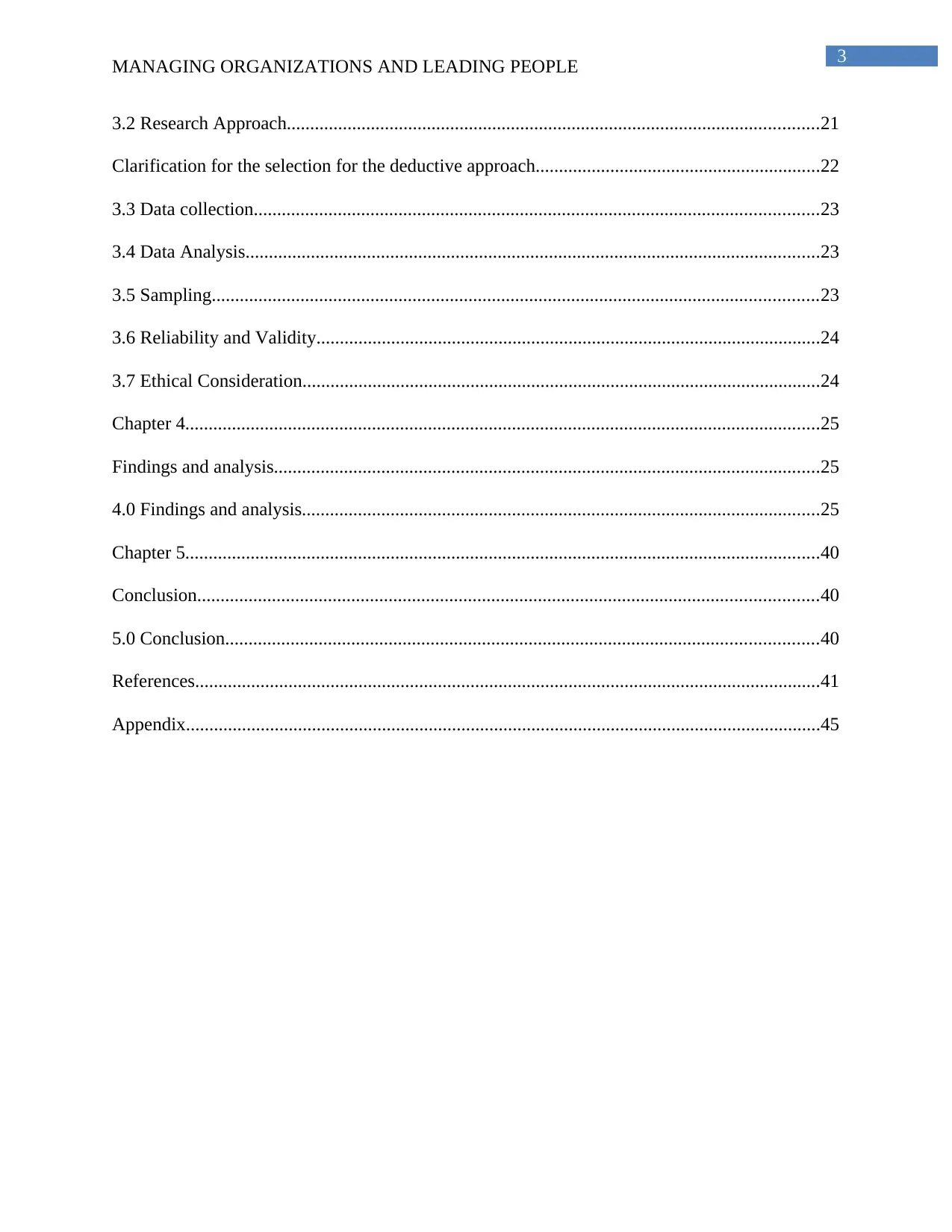
3
MANAGING ORGANIZATIONS AND LEADING PEOPLE
3.2 Research Approach..................................................................................................................21
Clarification for the selection for the deductive approach.............................................................22
3.3 Data collection.........................................................................................................................23
3.4 Data Analysis...........................................................................................................................23
3.5 Sampling..................................................................................................................................23
3.6 Reliability and Validity............................................................................................................24
3.7 Ethical Consideration...............................................................................................................24
Chapter 4........................................................................................................................................25
Findings and analysis.....................................................................................................................25
4.0 Findings and analysis...............................................................................................................25
Chapter 5........................................................................................................................................40
Conclusion.....................................................................................................................................40
5.0 Conclusion...............................................................................................................................40
References......................................................................................................................................41
Appendix........................................................................................................................................45
MANAGING ORGANIZATIONS AND LEADING PEOPLE
3.2 Research Approach..................................................................................................................21
Clarification for the selection for the deductive approach.............................................................22
3.3 Data collection.........................................................................................................................23
3.4 Data Analysis...........................................................................................................................23
3.5 Sampling..................................................................................................................................23
3.6 Reliability and Validity............................................................................................................24
3.7 Ethical Consideration...............................................................................................................24
Chapter 4........................................................................................................................................25
Findings and analysis.....................................................................................................................25
4.0 Findings and analysis...............................................................................................................25
Chapter 5........................................................................................................................................40
Conclusion.....................................................................................................................................40
5.0 Conclusion...............................................................................................................................40
References......................................................................................................................................41
Appendix........................................................................................................................................45
Paraphrase This Document
Need a fresh take? Get an instant paraphrase of this document with our AI Paraphraser
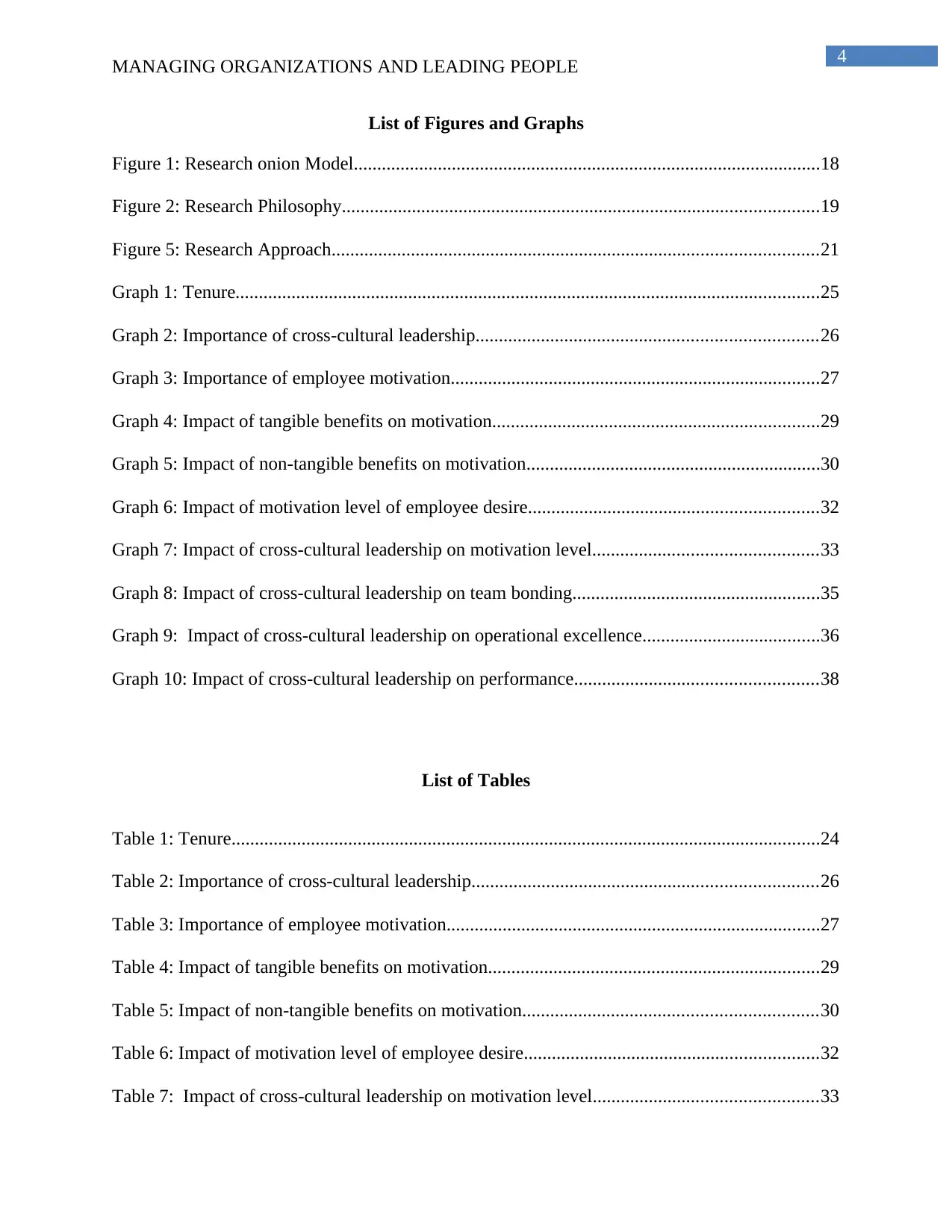
4
MANAGING ORGANIZATIONS AND LEADING PEOPLE
List of Figures and Graphs
Figure 1: Research onion Model....................................................................................................18
Figure 2: Research Philosophy......................................................................................................19
Figure 5: Research Approach........................................................................................................21
Graph 1: Tenure.............................................................................................................................25
Graph 2: Importance of cross-cultural leadership.........................................................................26
Graph 3: Importance of employee motivation...............................................................................27
Graph 4: Impact of tangible benefits on motivation......................................................................29
Graph 5: Impact of non-tangible benefits on motivation...............................................................30
Graph 6: Impact of motivation level of employee desire..............................................................32
Graph 7: Impact of cross-cultural leadership on motivation level................................................33
Graph 8: Impact of cross-cultural leadership on team bonding.....................................................35
Graph 9: Impact of cross-cultural leadership on operational excellence......................................36
Graph 10: Impact of cross-cultural leadership on performance....................................................38
List of Tables
Table 1: Tenure..............................................................................................................................24
Table 2: Importance of cross-cultural leadership..........................................................................26
Table 3: Importance of employee motivation................................................................................27
Table 4: Impact of tangible benefits on motivation.......................................................................29
Table 5: Impact of non-tangible benefits on motivation...............................................................30
Table 6: Impact of motivation level of employee desire...............................................................32
Table 7: Impact of cross-cultural leadership on motivation level................................................33
MANAGING ORGANIZATIONS AND LEADING PEOPLE
List of Figures and Graphs
Figure 1: Research onion Model....................................................................................................18
Figure 2: Research Philosophy......................................................................................................19
Figure 5: Research Approach........................................................................................................21
Graph 1: Tenure.............................................................................................................................25
Graph 2: Importance of cross-cultural leadership.........................................................................26
Graph 3: Importance of employee motivation...............................................................................27
Graph 4: Impact of tangible benefits on motivation......................................................................29
Graph 5: Impact of non-tangible benefits on motivation...............................................................30
Graph 6: Impact of motivation level of employee desire..............................................................32
Graph 7: Impact of cross-cultural leadership on motivation level................................................33
Graph 8: Impact of cross-cultural leadership on team bonding.....................................................35
Graph 9: Impact of cross-cultural leadership on operational excellence......................................36
Graph 10: Impact of cross-cultural leadership on performance....................................................38
List of Tables
Table 1: Tenure..............................................................................................................................24
Table 2: Importance of cross-cultural leadership..........................................................................26
Table 3: Importance of employee motivation................................................................................27
Table 4: Impact of tangible benefits on motivation.......................................................................29
Table 5: Impact of non-tangible benefits on motivation...............................................................30
Table 6: Impact of motivation level of employee desire...............................................................32
Table 7: Impact of cross-cultural leadership on motivation level................................................33
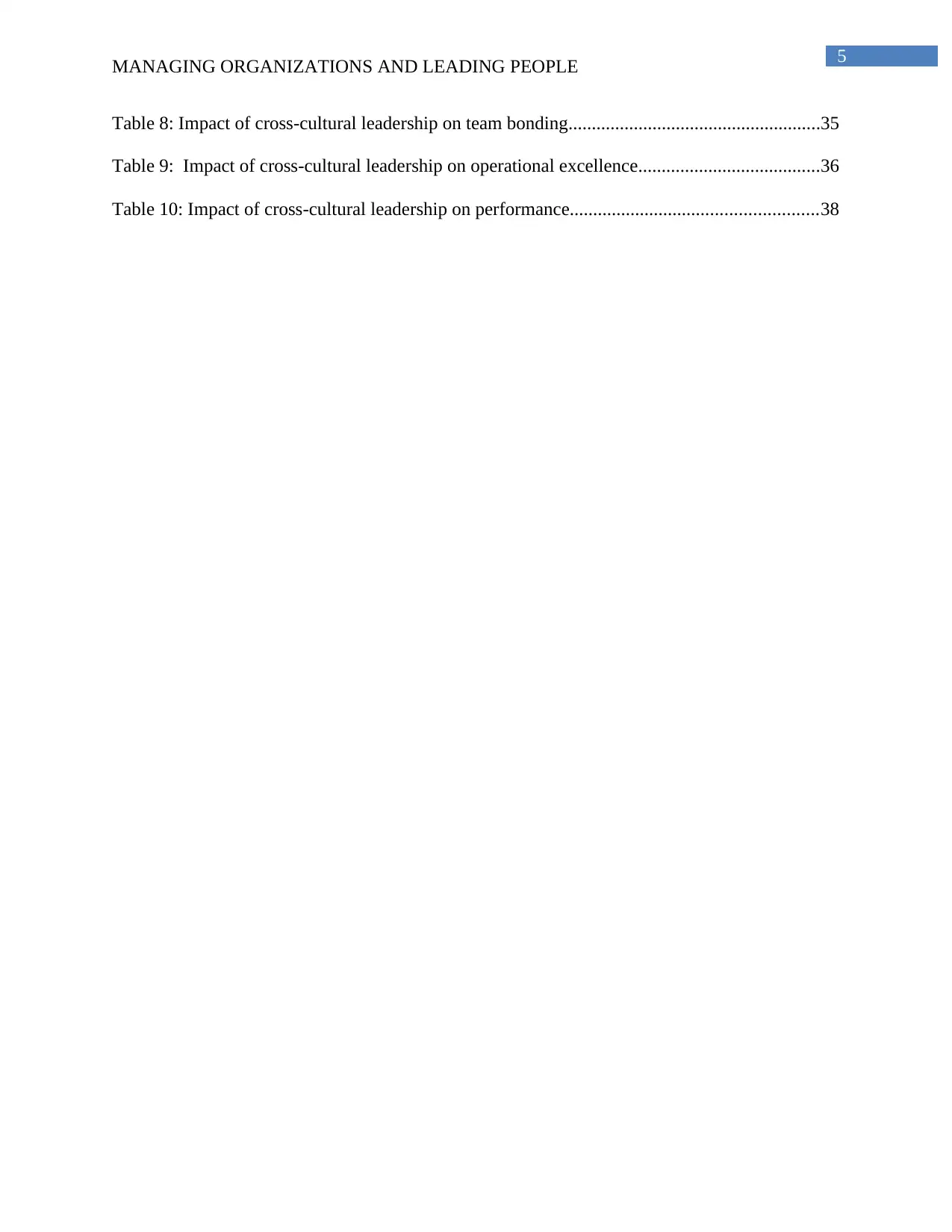
5
MANAGING ORGANIZATIONS AND LEADING PEOPLE
Table 8: Impact of cross-cultural leadership on team bonding......................................................35
Table 9: Impact of cross-cultural leadership on operational excellence.......................................36
Table 10: Impact of cross-cultural leadership on performance.....................................................38
MANAGING ORGANIZATIONS AND LEADING PEOPLE
Table 8: Impact of cross-cultural leadership on team bonding......................................................35
Table 9: Impact of cross-cultural leadership on operational excellence.......................................36
Table 10: Impact of cross-cultural leadership on performance.....................................................38
⊘ This is a preview!⊘
Do you want full access?
Subscribe today to unlock all pages.

Trusted by 1+ million students worldwide
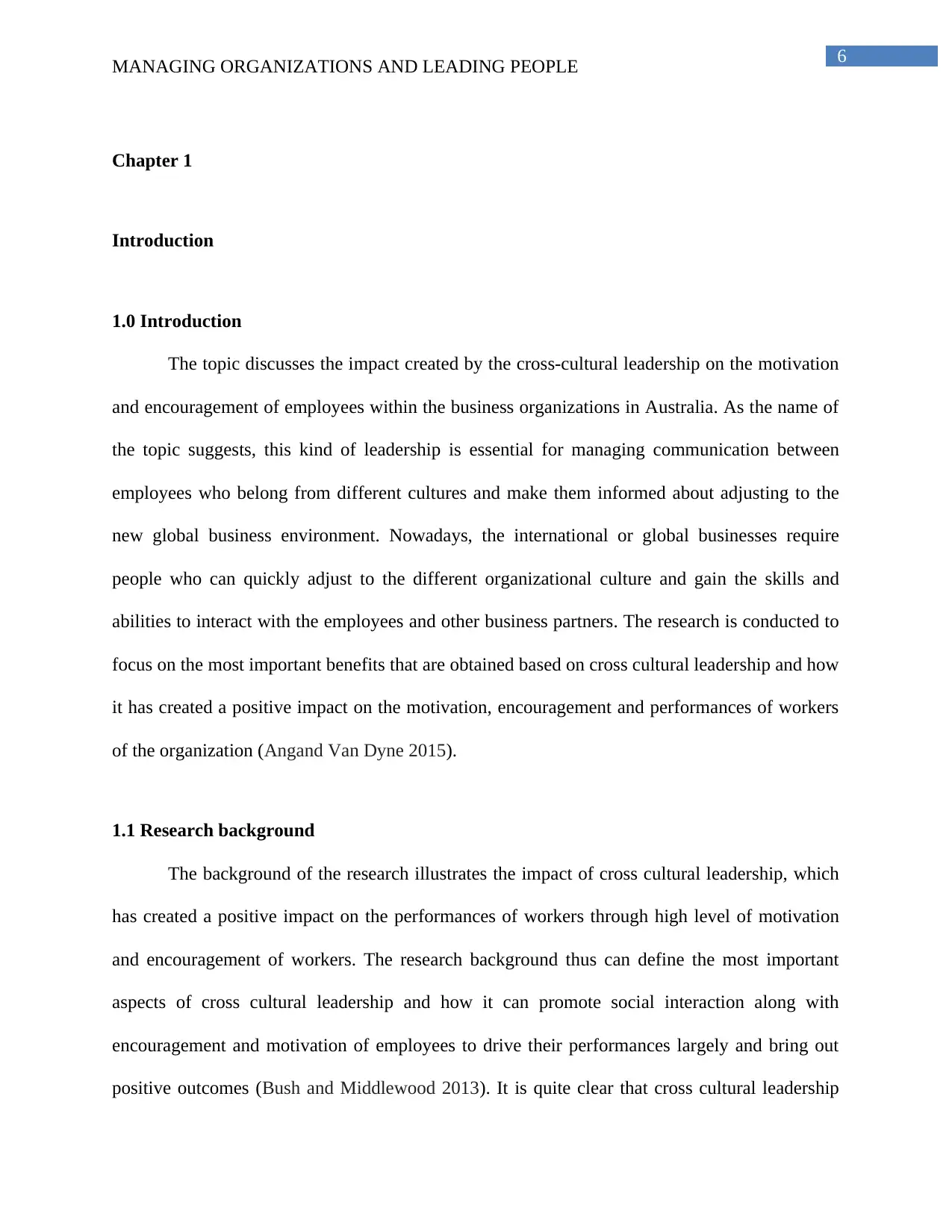
6
MANAGING ORGANIZATIONS AND LEADING PEOPLE
Chapter 1
Introduction
1.0 Introduction
The topic discusses the impact created by the cross-cultural leadership on the motivation
and encouragement of employees within the business organizations in Australia. As the name of
the topic suggests, this kind of leadership is essential for managing communication between
employees who belong from different cultures and make them informed about adjusting to the
new global business environment. Nowadays, the international or global businesses require
people who can quickly adjust to the different organizational culture and gain the skills and
abilities to interact with the employees and other business partners. The research is conducted to
focus on the most important benefits that are obtained based on cross cultural leadership and how
it has created a positive impact on the motivation, encouragement and performances of workers
of the organization (Angand Van Dyne 2015).
1.1 Research background
The background of the research illustrates the impact of cross cultural leadership, which
has created a positive impact on the performances of workers through high level of motivation
and encouragement of workers. The research background thus can define the most important
aspects of cross cultural leadership and how it can promote social interaction along with
encouragement and motivation of employees to drive their performances largely and bring out
positive outcomes (Bush and Middlewood 2013). It is quite clear that cross cultural leadership
MANAGING ORGANIZATIONS AND LEADING PEOPLE
Chapter 1
Introduction
1.0 Introduction
The topic discusses the impact created by the cross-cultural leadership on the motivation
and encouragement of employees within the business organizations in Australia. As the name of
the topic suggests, this kind of leadership is essential for managing communication between
employees who belong from different cultures and make them informed about adjusting to the
new global business environment. Nowadays, the international or global businesses require
people who can quickly adjust to the different organizational culture and gain the skills and
abilities to interact with the employees and other business partners. The research is conducted to
focus on the most important benefits that are obtained based on cross cultural leadership and how
it has created a positive impact on the motivation, encouragement and performances of workers
of the organization (Angand Van Dyne 2015).
1.1 Research background
The background of the research illustrates the impact of cross cultural leadership, which
has created a positive impact on the performances of workers through high level of motivation
and encouragement of workers. The research background thus can define the most important
aspects of cross cultural leadership and how it can promote social interaction along with
encouragement and motivation of employees to drive their performances largely and bring out
positive outcomes (Bush and Middlewood 2013). It is quite clear that cross cultural leadership
Paraphrase This Document
Need a fresh take? Get an instant paraphrase of this document with our AI Paraphraser
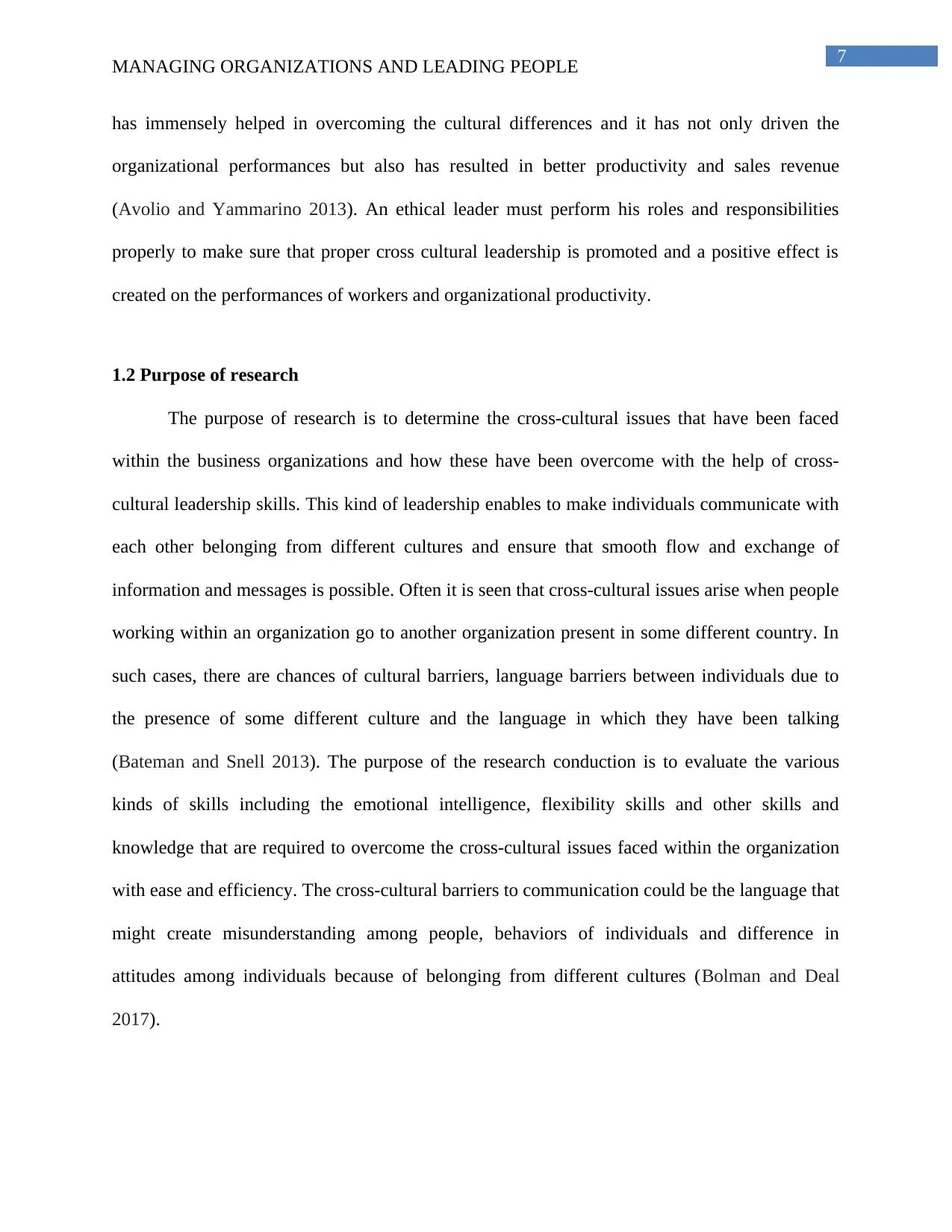
7
MANAGING ORGANIZATIONS AND LEADING PEOPLE
has immensely helped in overcoming the cultural differences and it has not only driven the
organizational performances but also has resulted in better productivity and sales revenue
(Avolio and Yammarino 2013). An ethical leader must perform his roles and responsibilities
properly to make sure that proper cross cultural leadership is promoted and a positive effect is
created on the performances of workers and organizational productivity.
1.2 Purpose of research
The purpose of research is to determine the cross-cultural issues that have been faced
within the business organizations and how these have been overcome with the help of cross-
cultural leadership skills. This kind of leadership enables to make individuals communicate with
each other belonging from different cultures and ensure that smooth flow and exchange of
information and messages is possible. Often it is seen that cross-cultural issues arise when people
working within an organization go to another organization present in some different country. In
such cases, there are chances of cultural barriers, language barriers between individuals due to
the presence of some different culture and the language in which they have been talking
(Bateman and Snell 2013). The purpose of the research conduction is to evaluate the various
kinds of skills including the emotional intelligence, flexibility skills and other skills and
knowledge that are required to overcome the cross-cultural issues faced within the organization
with ease and efficiency. The cross-cultural barriers to communication could be the language that
might create misunderstanding among people, behaviors of individuals and difference in
attitudes among individuals because of belonging from different cultures (Bolman and Deal
2017).
MANAGING ORGANIZATIONS AND LEADING PEOPLE
has immensely helped in overcoming the cultural differences and it has not only driven the
organizational performances but also has resulted in better productivity and sales revenue
(Avolio and Yammarino 2013). An ethical leader must perform his roles and responsibilities
properly to make sure that proper cross cultural leadership is promoted and a positive effect is
created on the performances of workers and organizational productivity.
1.2 Purpose of research
The purpose of research is to determine the cross-cultural issues that have been faced
within the business organizations and how these have been overcome with the help of cross-
cultural leadership skills. This kind of leadership enables to make individuals communicate with
each other belonging from different cultures and ensure that smooth flow and exchange of
information and messages is possible. Often it is seen that cross-cultural issues arise when people
working within an organization go to another organization present in some different country. In
such cases, there are chances of cultural barriers, language barriers between individuals due to
the presence of some different culture and the language in which they have been talking
(Bateman and Snell 2013). The purpose of the research conduction is to evaluate the various
kinds of skills including the emotional intelligence, flexibility skills and other skills and
knowledge that are required to overcome the cross-cultural issues faced within the organization
with ease and efficiency. The cross-cultural barriers to communication could be the language that
might create misunderstanding among people, behaviors of individuals and difference in
attitudes among individuals because of belonging from different cultures (Bolman and Deal
2017).
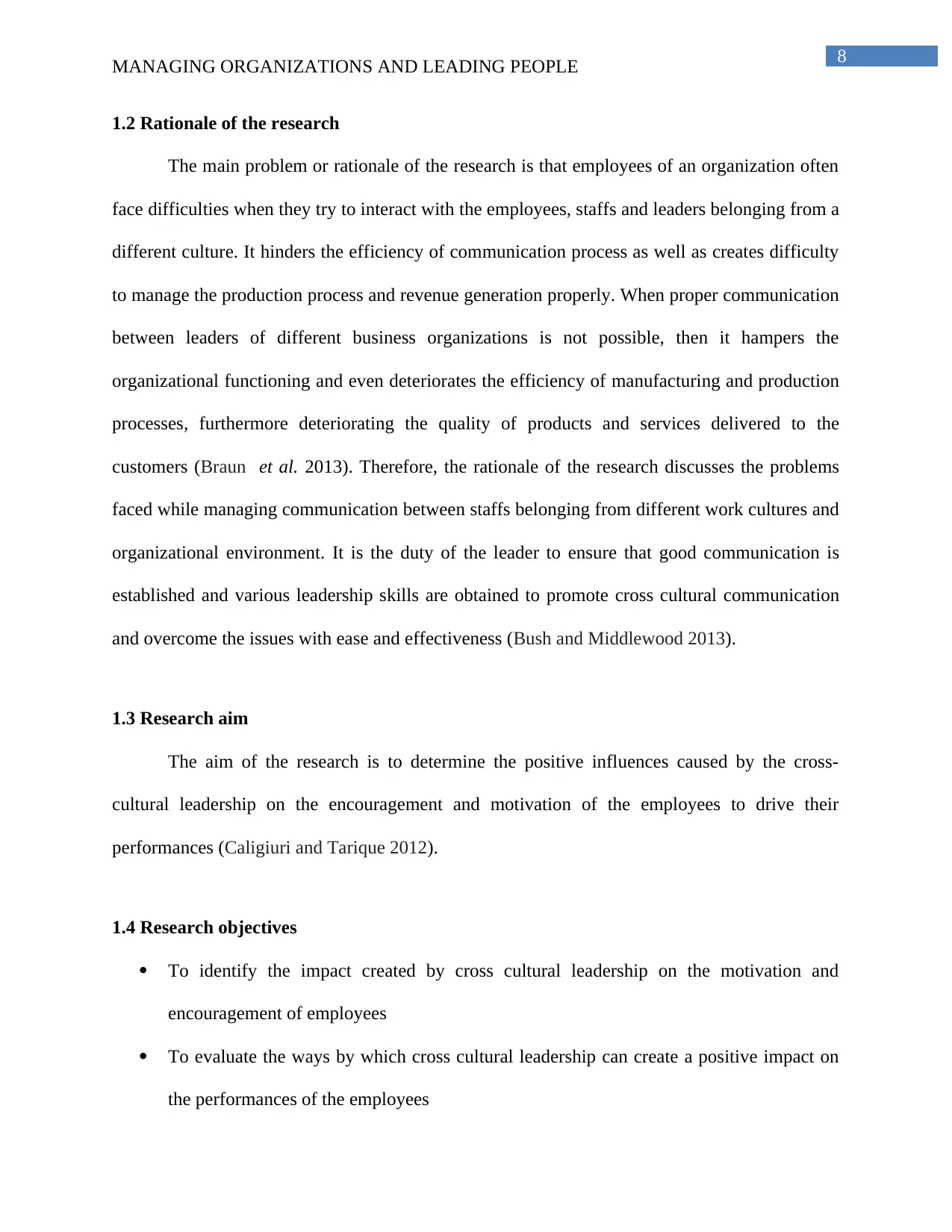
8
MANAGING ORGANIZATIONS AND LEADING PEOPLE
1.2 Rationale of the research
The main problem or rationale of the research is that employees of an organization often
face difficulties when they try to interact with the employees, staffs and leaders belonging from a
different culture. It hinders the efficiency of communication process as well as creates difficulty
to manage the production process and revenue generation properly. When proper communication
between leaders of different business organizations is not possible, then it hampers the
organizational functioning and even deteriorates the efficiency of manufacturing and production
processes, furthermore deteriorating the quality of products and services delivered to the
customers (Braun et al. 2013). Therefore, the rationale of the research discusses the problems
faced while managing communication between staffs belonging from different work cultures and
organizational environment. It is the duty of the leader to ensure that good communication is
established and various leadership skills are obtained to promote cross cultural communication
and overcome the issues with ease and effectiveness (Bush and Middlewood 2013).
1.3 Research aim
The aim of the research is to determine the positive influences caused by the cross-
cultural leadership on the encouragement and motivation of the employees to drive their
performances (Caligiuri and Tarique 2012).
1.4 Research objectives
To identify the impact created by cross cultural leadership on the motivation and
encouragement of employees
To evaluate the ways by which cross cultural leadership can create a positive impact on
the performances of the employees
MANAGING ORGANIZATIONS AND LEADING PEOPLE
1.2 Rationale of the research
The main problem or rationale of the research is that employees of an organization often
face difficulties when they try to interact with the employees, staffs and leaders belonging from a
different culture. It hinders the efficiency of communication process as well as creates difficulty
to manage the production process and revenue generation properly. When proper communication
between leaders of different business organizations is not possible, then it hampers the
organizational functioning and even deteriorates the efficiency of manufacturing and production
processes, furthermore deteriorating the quality of products and services delivered to the
customers (Braun et al. 2013). Therefore, the rationale of the research discusses the problems
faced while managing communication between staffs belonging from different work cultures and
organizational environment. It is the duty of the leader to ensure that good communication is
established and various leadership skills are obtained to promote cross cultural communication
and overcome the issues with ease and effectiveness (Bush and Middlewood 2013).
1.3 Research aim
The aim of the research is to determine the positive influences caused by the cross-
cultural leadership on the encouragement and motivation of the employees to drive their
performances (Caligiuri and Tarique 2012).
1.4 Research objectives
To identify the impact created by cross cultural leadership on the motivation and
encouragement of employees
To evaluate the ways by which cross cultural leadership can create a positive impact on
the performances of the employees
⊘ This is a preview!⊘
Do you want full access?
Subscribe today to unlock all pages.

Trusted by 1+ million students worldwide
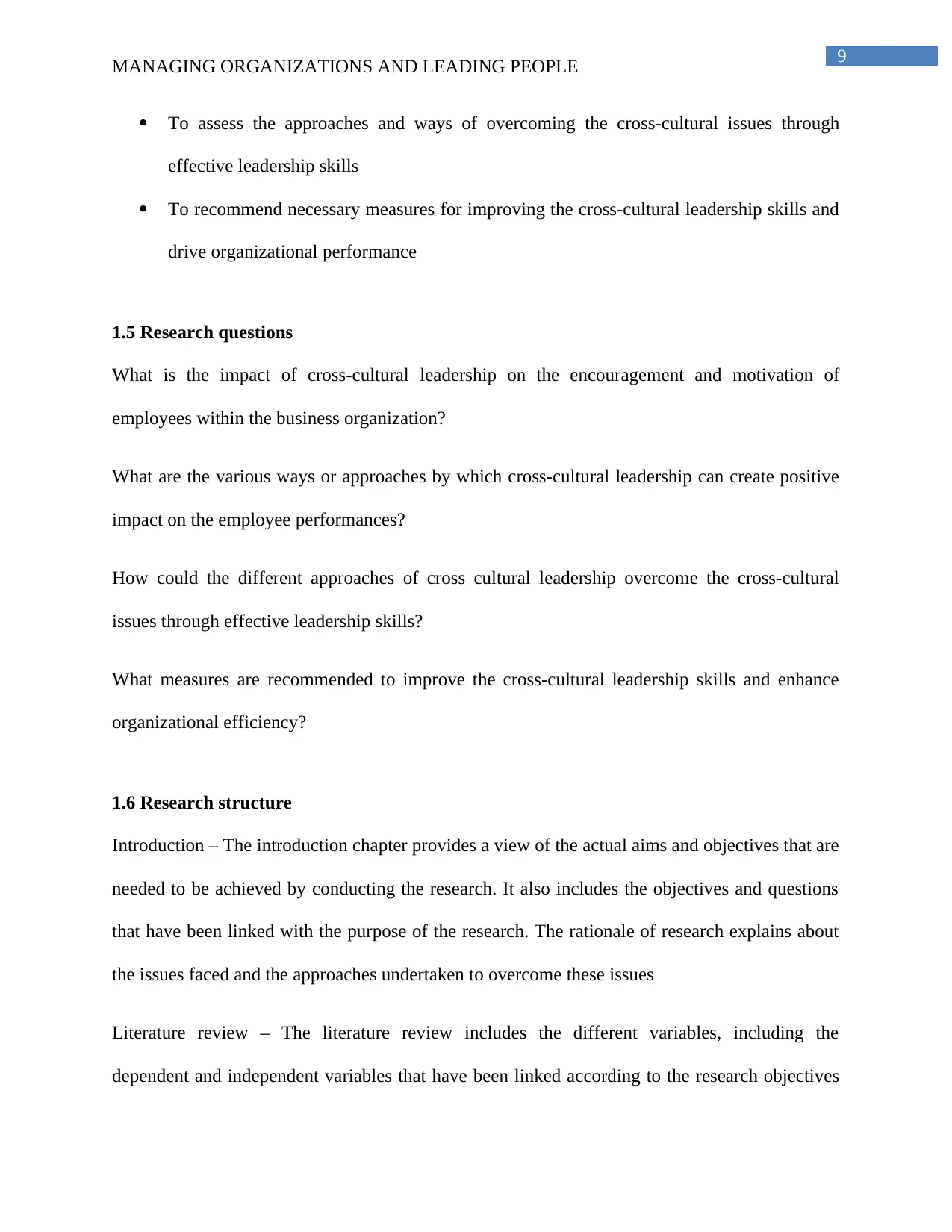
9
MANAGING ORGANIZATIONS AND LEADING PEOPLE
To assess the approaches and ways of overcoming the cross-cultural issues through
effective leadership skills
To recommend necessary measures for improving the cross-cultural leadership skills and
drive organizational performance
1.5 Research questions
What is the impact of cross-cultural leadership on the encouragement and motivation of
employees within the business organization?
What are the various ways or approaches by which cross-cultural leadership can create positive
impact on the employee performances?
How could the different approaches of cross cultural leadership overcome the cross-cultural
issues through effective leadership skills?
What measures are recommended to improve the cross-cultural leadership skills and enhance
organizational efficiency?
1.6 Research structure
Introduction – The introduction chapter provides a view of the actual aims and objectives that are
needed to be achieved by conducting the research. It also includes the objectives and questions
that have been linked with the purpose of the research. The rationale of research explains about
the issues faced and the approaches undertaken to overcome these issues
Literature review – The literature review includes the different variables, including the
dependent and independent variables that have been linked according to the research objectives
MANAGING ORGANIZATIONS AND LEADING PEOPLE
To assess the approaches and ways of overcoming the cross-cultural issues through
effective leadership skills
To recommend necessary measures for improving the cross-cultural leadership skills and
drive organizational performance
1.5 Research questions
What is the impact of cross-cultural leadership on the encouragement and motivation of
employees within the business organization?
What are the various ways or approaches by which cross-cultural leadership can create positive
impact on the employee performances?
How could the different approaches of cross cultural leadership overcome the cross-cultural
issues through effective leadership skills?
What measures are recommended to improve the cross-cultural leadership skills and enhance
organizational efficiency?
1.6 Research structure
Introduction – The introduction chapter provides a view of the actual aims and objectives that are
needed to be achieved by conducting the research. It also includes the objectives and questions
that have been linked with the purpose of the research. The rationale of research explains about
the issues faced and the approaches undertaken to overcome these issues
Literature review – The literature review includes the different variables, including the
dependent and independent variables that have been linked according to the research objectives
Paraphrase This Document
Need a fresh take? Get an instant paraphrase of this document with our AI Paraphraser
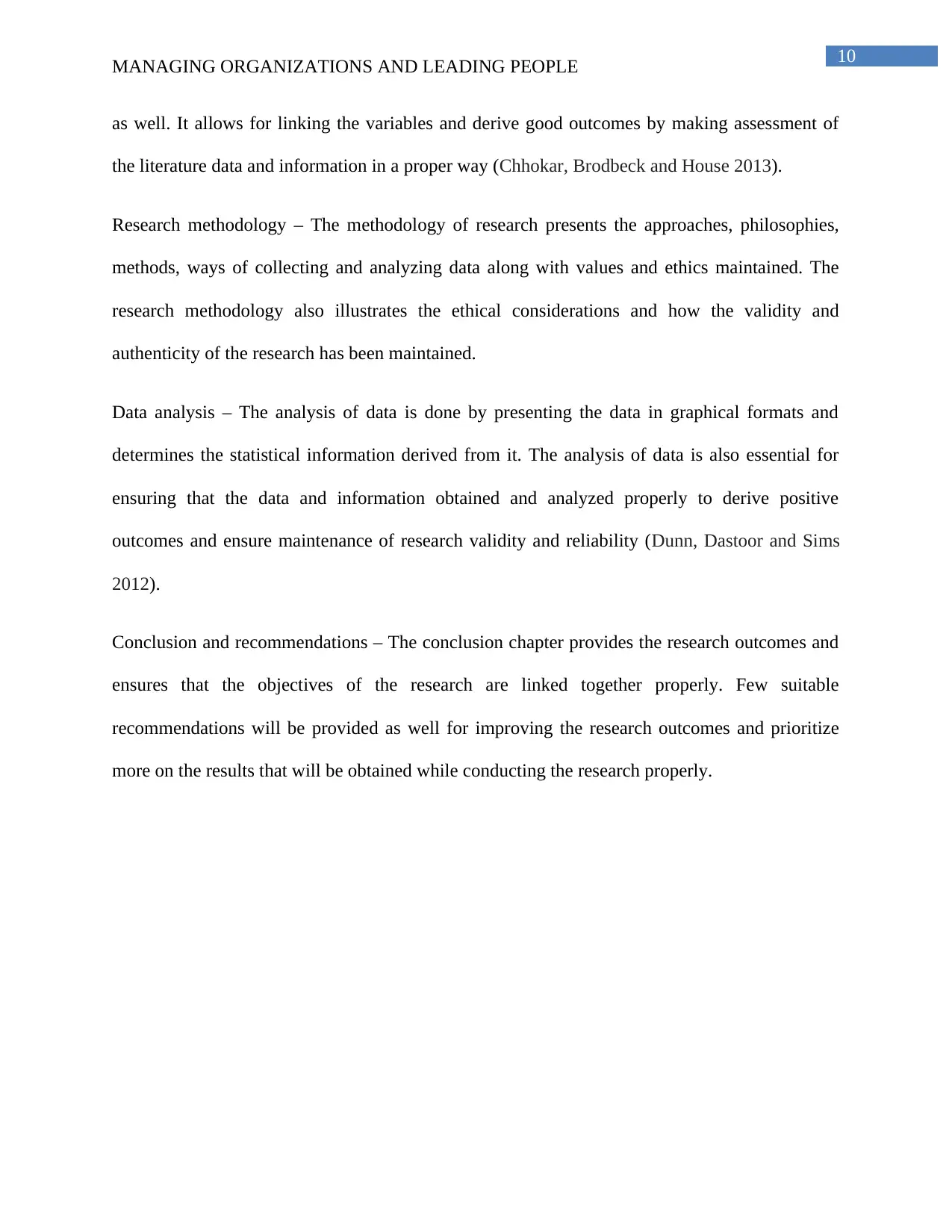
10
MANAGING ORGANIZATIONS AND LEADING PEOPLE
as well. It allows for linking the variables and derive good outcomes by making assessment of
the literature data and information in a proper way (Chhokar, Brodbeck and House 2013).
Research methodology – The methodology of research presents the approaches, philosophies,
methods, ways of collecting and analyzing data along with values and ethics maintained. The
research methodology also illustrates the ethical considerations and how the validity and
authenticity of the research has been maintained.
Data analysis – The analysis of data is done by presenting the data in graphical formats and
determines the statistical information derived from it. The analysis of data is also essential for
ensuring that the data and information obtained and analyzed properly to derive positive
outcomes and ensure maintenance of research validity and reliability (Dunn, Dastoor and Sims
2012).
Conclusion and recommendations – The conclusion chapter provides the research outcomes and
ensures that the objectives of the research are linked together properly. Few suitable
recommendations will be provided as well for improving the research outcomes and prioritize
more on the results that will be obtained while conducting the research properly.
MANAGING ORGANIZATIONS AND LEADING PEOPLE
as well. It allows for linking the variables and derive good outcomes by making assessment of
the literature data and information in a proper way (Chhokar, Brodbeck and House 2013).
Research methodology – The methodology of research presents the approaches, philosophies,
methods, ways of collecting and analyzing data along with values and ethics maintained. The
research methodology also illustrates the ethical considerations and how the validity and
authenticity of the research has been maintained.
Data analysis – The analysis of data is done by presenting the data in graphical formats and
determines the statistical information derived from it. The analysis of data is also essential for
ensuring that the data and information obtained and analyzed properly to derive positive
outcomes and ensure maintenance of research validity and reliability (Dunn, Dastoor and Sims
2012).
Conclusion and recommendations – The conclusion chapter provides the research outcomes and
ensures that the objectives of the research are linked together properly. Few suitable
recommendations will be provided as well for improving the research outcomes and prioritize
more on the results that will be obtained while conducting the research properly.
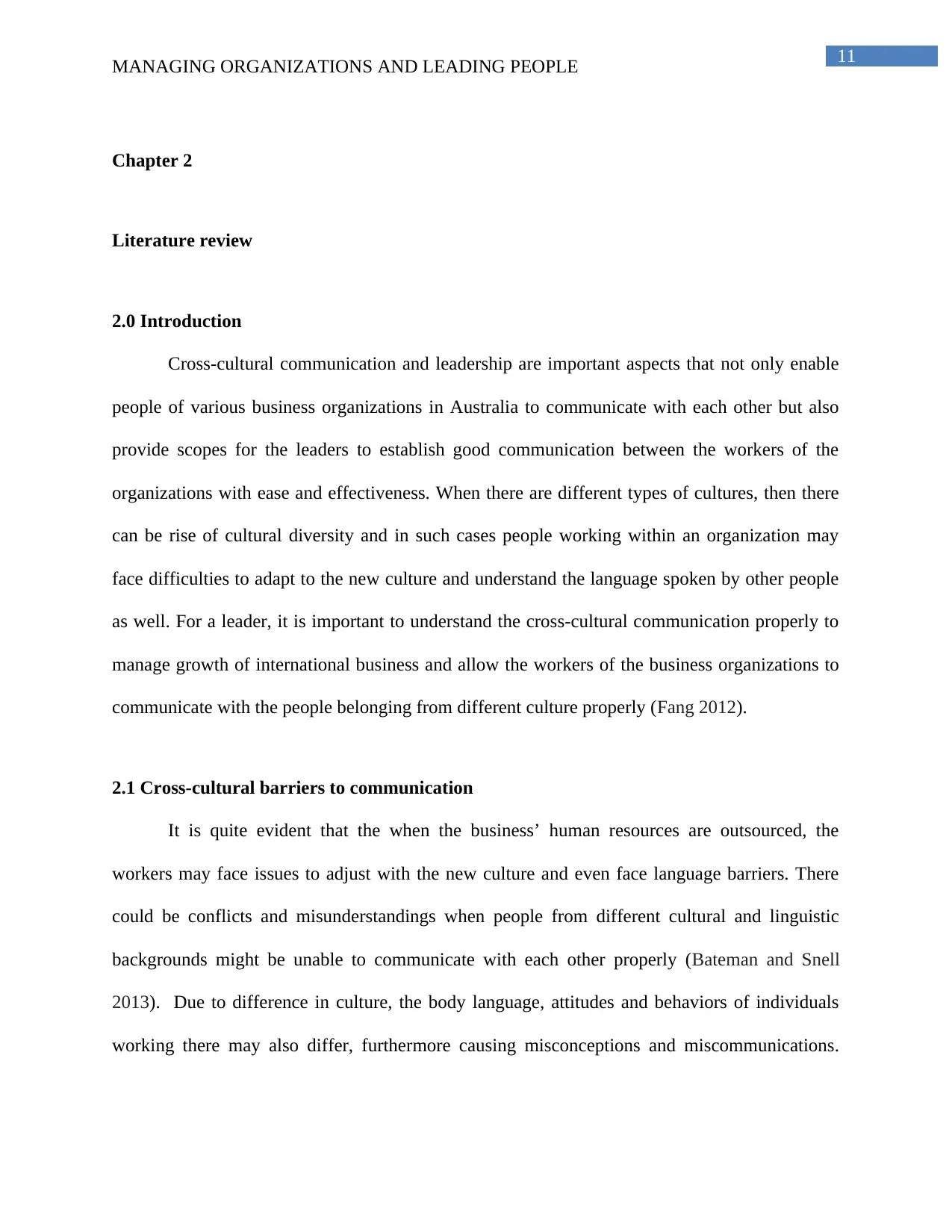
11
MANAGING ORGANIZATIONS AND LEADING PEOPLE
Chapter 2
Literature review
2.0 Introduction
Cross-cultural communication and leadership are important aspects that not only enable
people of various business organizations in Australia to communicate with each other but also
provide scopes for the leaders to establish good communication between the workers of the
organizations with ease and effectiveness. When there are different types of cultures, then there
can be rise of cultural diversity and in such cases people working within an organization may
face difficulties to adapt to the new culture and understand the language spoken by other people
as well. For a leader, it is important to understand the cross-cultural communication properly to
manage growth of international business and allow the workers of the business organizations to
communicate with the people belonging from different culture properly (Fang 2012).
2.1 Cross-cultural barriers to communication
It is quite evident that the when the business’ human resources are outsourced, the
workers may face issues to adjust with the new culture and even face language barriers. There
could be conflicts and misunderstandings when people from different cultural and linguistic
backgrounds might be unable to communicate with each other properly (Bateman and Snell
2013). Due to difference in culture, the body language, attitudes and behaviors of individuals
working there may also differ, furthermore causing misconceptions and miscommunications.
MANAGING ORGANIZATIONS AND LEADING PEOPLE
Chapter 2
Literature review
2.0 Introduction
Cross-cultural communication and leadership are important aspects that not only enable
people of various business organizations in Australia to communicate with each other but also
provide scopes for the leaders to establish good communication between the workers of the
organizations with ease and effectiveness. When there are different types of cultures, then there
can be rise of cultural diversity and in such cases people working within an organization may
face difficulties to adapt to the new culture and understand the language spoken by other people
as well. For a leader, it is important to understand the cross-cultural communication properly to
manage growth of international business and allow the workers of the business organizations to
communicate with the people belonging from different culture properly (Fang 2012).
2.1 Cross-cultural barriers to communication
It is quite evident that the when the business’ human resources are outsourced, the
workers may face issues to adjust with the new culture and even face language barriers. There
could be conflicts and misunderstandings when people from different cultural and linguistic
backgrounds might be unable to communicate with each other properly (Bateman and Snell
2013). Due to difference in culture, the body language, attitudes and behaviors of individuals
working there may also differ, furthermore causing misconceptions and miscommunications.
⊘ This is a preview!⊘
Do you want full access?
Subscribe today to unlock all pages.

Trusted by 1+ million students worldwide
1 out of 53
Related Documents
Your All-in-One AI-Powered Toolkit for Academic Success.
+13062052269
info@desklib.com
Available 24*7 on WhatsApp / Email
![[object Object]](/_next/static/media/star-bottom.7253800d.svg)
Unlock your academic potential
Copyright © 2020–2025 A2Z Services. All Rights Reserved. Developed and managed by ZUCOL.




